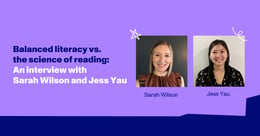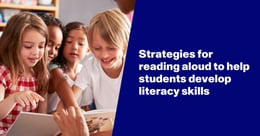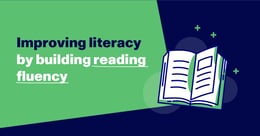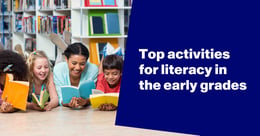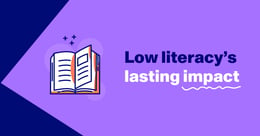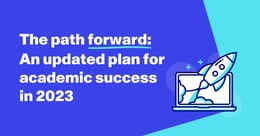
Responsive strategies for the teaching of literacy
Just as the teaching of literacy empowers students to learn deeply about the world around them, it also enables them to begin writing their own futures.
Few topics in K-12 education may be simultaneously as foundational and as personal as learning how to read and write. That’s why the discussion about how to teach reading elicits such strong opinions from teachers, administrators, scholars, family members, and others.
But even as a consensus emerges among all these various stakeholders about the best overarching strategy to use, we still have to keep one very important truth in mind: No two students are the same.
To drive learning for every child in the classroom, teachers have to employ strategies that are truly reflective of the diverse needs of the students they work with every day.
Literacy strategies for reading when students’ skill levels vary
A certain amount of variation in academic progress is to be expected in many classrooms, but the current state of the balanced literacy versus science of reading debate could make for a particularly heterogenous grouping of ability levels in early grades today.
Many districts have changed curricula in recent years, and as students begin to participate in literacy lessons that are more structured and sequential than they’ve experienced in the past, teachers could be left working to fill in knowledge gaps for individual students.
“At the beginning of a school year, you can have 25 third graders who start out on 25 different stairs,” said Sarah Wilson, a former elementary school teacher who currently serves as a professional learning specialist with Paper™. “The teacher is supposed to use a systematic approach that starts at stair 12, but not every student in that classroom is starting out on that step.”
In such an environment, effective differentiation can be key.
Ongoing assessment and tailored small-group support
Writing in Edutopia, Colorado educator and administrator Tony Winger discusses how his school implemented a differentiated reading instruction program. The guided reading block was replaced with a new system for literacy practice in which classroom teachers, specialists, and special education teachers collaborated to help students fill specific gaps in their understanding. Phonological awareness assessments, phonics surveys, spelling exams, and timed reading tests that focused on fluency were used to establish and rebalance groups.
[READ: “Raising reading fluency to improve K-12 literacy”]
Explicit instruction for building baseline literacy skills
When students lack the necessary prior knowledge around phonics and phonological awareness to develop fluency, explicit instruction can help them build the foundation they need. As the Massachusetts Department of Elementary and Secondary Education outlines in a primer on differentiated instruction for literacy blocks, such small-group direct instruction should involve:
- Explicit modeling for targeted foundational skills.
- Practice opportunities in which students can receive immediate feedback.
- Prompts for applying the targeted skill in new, more generalized scenarios.
Tiered assignments and targeted activities
Within learning centers and while working independently, scaffolded activities and assignments help learners hone important skills to become better readers. Asking students to complete graphic organizers—which can also act as quick, informal assessments—can be one method of giving students a helpful scaffold for approaching the main ideas of a text.
Likewise, a Houghton Mifflin Harcourt blog post on differentiated reading instruction techniques explores various reading comprehension strategies teachers can assign for groups of learners, including:
- Summarizing the passage.
- Responding to specific questions.
- Rewriting the story from a different perspective.
Culturally affirming literacy instruction
In addition to learners bringing a range of literacy skill levels into the classroom, students’ lived experiences can also vary widely based on race, ethnicity, home language, socioeconomic status, and other factors. When educators assign diverse texts and use teaching strategies that honor students’ backgrounds, they can more effectively help learners develop the unique strengths they bring to ELA lessons.
Asset-based classroom practices
Several aspects of culturally affirming teaching practices can be applied across content areas, and these techniques also require deep commitment and sustained work.
In an article about culturally responsive literacy instructional strategies, Joan Sedita, the founder of Keys to Literacy, summarizes existing research on culturally responsive teaching and outlines several aspects of this approach that are especially relevant to literacy classrooms.
In particular, Sedita notes that a culturally responsive perspective emphasizes:
- An asset-based approach to cultural and linguistic diversity.
- High expectations for all students in the classroom.
- Direct instruction of metacognitive comprehension strategies.
- Culturally informed opportunities to learn and develop discussion skills.
Crucially, these strategies must be tailored to the unique classroom environment—not reduced to a simplistic procedure or a generalized set of assumptions.
Identity-affirming texts
There’s no single answer to what the purpose of reading is. Students and adults alike read for information, enjoyment, and more. But for developing readers, the opportunity to connect deeply with a wide range of texts can make all the difference in setting the stage for lifelong literacy and ongoing academic engagement.
In an article from NWEA, experts affirm that interactions with identify-affirming reading passages help learners develop greater agency in the classroom while also fostering self-worth.
Dialect, home languages, and the science of reading
Sedita’s article mentions that educators have to foster dialect awareness and cultivate respect for students’ home languages throughout the literacy instruction process. As an Education Week article about the research on English learners and the science of reading points out, this can mean that some students may need additional vocabulary support and spoken-language instruction concurrent with phonics lessons or that they may need other kinds of scaffolding. Again, by using an asset-based perspective, teachers can encourage students to become strong readers while also honoring the unique strengths they bring with them into the classroom.
Boys, reading, and lifelong educational outcomes
Writing in The Atlantic, Alia Wong explores a familiar and vexing problem for many people who study the teaching of literacy: Boys need to read more. Citing several studies from around the world, Wong notes that boys tend to read less—and they enjoy it less too.
Because reading is so fundamental to a student’s overall educational experience, this gender disparity can lead to long-lasting impacts on educational outcomes. And as a Deloitte Insights article points out, the gender gap in reading tends to persist into adulthood, where grown men read fewer books and read less frequently. In addition to impacting educational achievement, the authors point out that people who read more books tend to live longer and may benefit from having more highly developed senses of empathy, emotional intelligence, or other life skills.
So how do we make sure boys are able to enjoy the many advantages that come from being an enthusiastic reader? Broadening the kinds of reading material, educational activities, and literacy role models present in the classroom can give boys—and, in fact, all students—a boost.
Switch up available texts by genre, format, and more
What do boys like to read?
Truthfully, each child is unique, so there’s no simple answer here—and teachers, librarians, and family members have to be careful not to fall into the trap of relying on stereotypes.
As a general point of reference, research on international school systems from the Organization for Economic Cooperation and Development highlights that magazines and fiction appeal to girls more so than boys. On the other hand, boys were more avid readers of comic books and newspapers than girls. Still, girls were more likely to say they read newspapers than fiction—and more boys read magazines than comic books—so the story is nuanced.
The bottom line? Give all kids access to a rich variety of texts, help them explore everything that’s available, and encourage them to read other books, articles, and stories related to their interests.
Institute group activity circles that support self-selected reading options
Group activities can transform reading from a solitary activity into a social experience, and there are several shared assignments that work well with the kinds of self-selected texts we’ve already discussed. These activities can also help students practice higher-level literacy skills.
A helpful article about how to engage boys in reading from the education college at Ohio State University describes two specific strategies everybody in the classroom could benefit from:
- Idea circles: Groups are formed around specific topics, and learners select different texts to read related to the idea or concept their circle is focused on. Students write about what they’ve learned, or they share their findings while working together on a project.
- Literature circles: Learners choose what to read and form groups around shared texts. They then work together by answering questions and discussing what they’ve read.
Find reading role models students can relate to
Is reading manly?
It may seem like a silly question, but many boys—whether implicitly or directly—get the message that books are for girls.
That’s why programs like Real Men Read bring community volunteers into young learners’ lives for exciting storytelling sessions. Students can share meaningful experiences that show them reading is for everybody.
Plus, what teacher wouldn’t want to have more fun opportunities for students to hear qualified volunteers read aloud to the class?
[READ: “How does reading aloud help students to develop literacy skills?”]
Students’ literacy needs are wide and varied
Every learner’s literacy journey is unique. To teach students how to read—and to help them fall in love with reading—effective teachers have to tailor their approach to the varied needs of all the unique individuals who make up their classroom.
Want to read more about important topics in literacy development? Check out our K-12 guide on how to teach reading.

